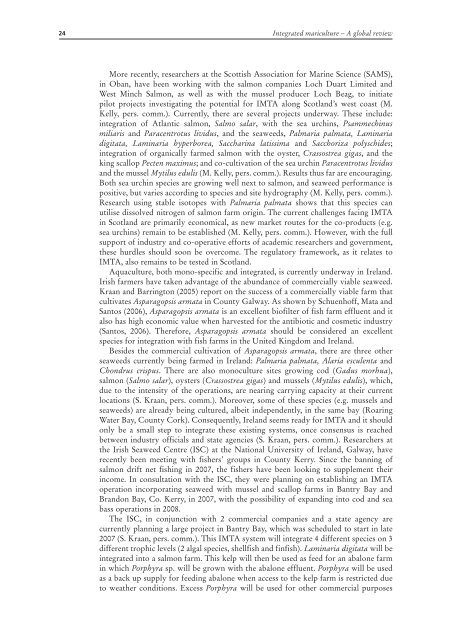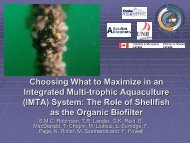Integrated multi-trophic aquaculture (IMTA) in marine temperate waters
Integrated multi-trophic aquaculture (IMTA) in marine temperate waters
Integrated multi-trophic aquaculture (IMTA) in marine temperate waters
Create successful ePaper yourself
Turn your PDF publications into a flip-book with our unique Google optimized e-Paper software.
24<br />
<strong>Integrated</strong> mariculture – A global review<br />
More recently, researchers at the Scottish Association for Mar<strong>in</strong>e Science (SAMS),<br />
<strong>in</strong> Oban, have been work<strong>in</strong>g with the salmon companies Loch Duart Limited and<br />
West M<strong>in</strong>ch Salmon, as well as with the mussel producer Loch Beag, to <strong>in</strong>itiate<br />
pilot projects <strong>in</strong>vestigat<strong>in</strong>g the potential for <strong>IMTA</strong> along Scotland’s west coast (M.<br />
Kelly, pers. comm.). Currently, there are several projects underway. These <strong>in</strong>clude:<br />
<strong>in</strong>tegration of Atlantic salmon, Salmo salar, with the sea urch<strong>in</strong>s, Psammech<strong>in</strong>us<br />
miliaris and Paracentrotus lividus, and the seaweeds, Palmaria palmata, Lam<strong>in</strong>aria<br />
digitata, Lam<strong>in</strong>aria hyperborea, Sacchar<strong>in</strong>a latissima and Sacchoriza polyschides;<br />
<strong>in</strong>tegration of organically farmed salmon with the oyster, Crassostrea gigas, and the<br />
k<strong>in</strong>g scallop Pecten maximus; and co-cultivation of the sea urch<strong>in</strong> Paracentrotus lividus<br />
and the mussel Mytilus edulis (M. Kelly, pers. comm.). Results thus far are encourag<strong>in</strong>g.<br />
Both sea urch<strong>in</strong> species are grow<strong>in</strong>g well next to salmon, and seaweed performance is<br />
positive, but varies accord<strong>in</strong>g to species and site hydrography (M. Kelly, pers. comm.).<br />
Research us<strong>in</strong>g stable isotopes with Palmaria palmata shows that this species can<br />
utilise dissolved nitrogen of salmon farm orig<strong>in</strong>. The current challenges fac<strong>in</strong>g <strong>IMTA</strong><br />
<strong>in</strong> Scotland are primarily economical, as new market routes for the co-products (e.g.<br />
sea urch<strong>in</strong>s) rema<strong>in</strong> to be established (M. Kelly, pers. comm.). However, with the full<br />
support of <strong>in</strong>dustry and co-operative efforts of academic researchers and government,<br />
these hurdles should soon be overcome. The regulatory framework, as it relates to<br />
<strong>IMTA</strong>, also rema<strong>in</strong>s to be tested <strong>in</strong> Scotland.<br />
Aquaculture, both mono-specific and <strong>in</strong>tegrated, is currently underway <strong>in</strong> Ireland.<br />
Irish farmers have taken advantage of the abundance of commercially viable seaweed.<br />
Kraan and Barr<strong>in</strong>gton (2005) report on the success of a commercially viable farm that<br />
cultivates Asparagopsis armata <strong>in</strong> County Galway. As shown by Schuenhoff, Mata and<br />
Santos (2006), Asparagopsis armata is an excellent biofilter of fish farm effluent and it<br />
also has high economic value when harvested for the antibiotic and cosmetic <strong>in</strong>dustry<br />
(Santos, 2006). Therefore, Asparagopsis armata should be considered an excellent<br />
species for <strong>in</strong>tegration with fish farms <strong>in</strong> the United K<strong>in</strong>gdom and Ireland.<br />
Besides the commercial cultivation of Asparagopsis armata, there are three other<br />
seaweeds currently be<strong>in</strong>g farmed <strong>in</strong> Ireland: Palmaria palmata, Alaria esculenta and<br />
Chondrus crispus. There are also monoculture sites grow<strong>in</strong>g cod (Gadus morhua),<br />
salmon (Salmo salar), oysters (Crassostrea gigas) and mussels (Mytilus edulis), which,<br />
due to the <strong>in</strong>tensity of the operations, are near<strong>in</strong>g carry<strong>in</strong>g capacity at their current<br />
locations (S. Kraan, pers. comm.). Moreover, some of these species (e.g. mussels and<br />
seaweeds) are already be<strong>in</strong>g cultured, albeit <strong>in</strong>dependently, <strong>in</strong> the same bay (Roar<strong>in</strong>g<br />
Water Bay, County Cork). Consequently, Ireland seems ready for <strong>IMTA</strong> and it should<br />
only be a small step to <strong>in</strong>tegrate these exist<strong>in</strong>g systems, once consensus is reached<br />
between <strong>in</strong>dustry officials and state agencies (S. Kraan, pers. comm.). Researchers at<br />
the Irish Seaweed Centre (ISC) at the National University of Ireland, Galway, have<br />
recently been meet<strong>in</strong>g with fishers’ groups <strong>in</strong> County Kerry. S<strong>in</strong>ce the bann<strong>in</strong>g of<br />
salmon drift net fish<strong>in</strong>g <strong>in</strong> 2007, the fishers have been look<strong>in</strong>g to supplement their<br />
<strong>in</strong>come. In consultation with the ISC, they were plann<strong>in</strong>g on establish<strong>in</strong>g an <strong>IMTA</strong><br />
operation <strong>in</strong>corporat<strong>in</strong>g seaweed with mussel and scallop farms <strong>in</strong> Bantry Bay and<br />
Brandon Bay, Co. Kerry, <strong>in</strong> 2007, with the possibility of expand<strong>in</strong>g <strong>in</strong>to cod and sea<br />
bass operations <strong>in</strong> 2008.<br />
The ISC, <strong>in</strong> conjunction with 2 commercial companies and a state agency are<br />
currently plann<strong>in</strong>g a large project <strong>in</strong> Bantry Bay, which was scheduled to start <strong>in</strong> late<br />
2007 (S. Kraan, pers. comm.). This <strong>IMTA</strong> system will <strong>in</strong>tegrate 4 different species on 3<br />
different <strong>trophic</strong> levels (2 algal species, shellfish and f<strong>in</strong>fish). Lam<strong>in</strong>aria digitata will be<br />
<strong>in</strong>tegrated <strong>in</strong>to a salmon farm. This kelp will then be used as feed for an abalone farm<br />
<strong>in</strong> which Porphyra sp. will be grown with the abalone effluent. Porphyra will be used<br />
as a back up supply for feed<strong>in</strong>g abalone when access to the kelp farm is restricted due<br />
to weather conditions. Excess Porphyra will be used for other commercial purposes



